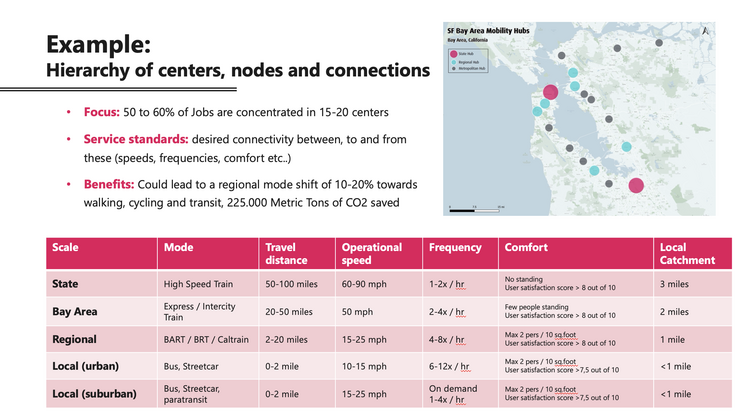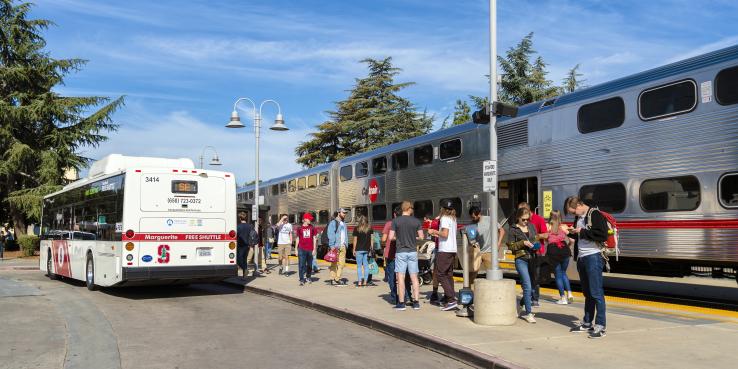Last year, the Metropolitan Transportation Commission (MTC) convened a Transit Recovery Task Force to stabilize and reimagine public transit in the face of a severe financial crisis brought on by the pandemic. The process culminated in the Transit Transformation Action Plan, which seeks to ensure that Bay Area transit services are equitably planned and integrally managed as a unified, efficient and reliable network. One of the first steps, targeted for completion in late 2023, is to develop a connected network plan, a strategic vision to guide planning and investment.
For the Bay Area, a connected network plan can clarify a long-term vision for the region’s transit system and facilitate the governance and funding reforms that will be needed to create a more rider-focused transit system and increase ridership. In this article, we’ll look at what a network plan is, why it’s important to do one and how it differs from other kinds of transportation plans. We’ll also recommend a scope for the Bay Area’s connected network plan.
What Is a Connected Network Plan?
A connected network plan lays out a strategic, long-range vision for a transit network in order to guide planning and investment decisions. Centered on connecting people and places, this type of plan is agnostic about what technology to use (heavy rail, light rail, bus, etc.) and which operator will provide service. Instead of asking, “Should agency X build and operate rail service between point A and point B?” a connected network plan asks, “What levels of transit service do we need between point A and point B?” In this way, it shifts the focus away from roles, responsibilities and specific modes and toward connecting people and places. In some places, a connected network plan is called a “service-based vision” or a “structuring network.”
Why Does the Bay Area Need This Plan?
There are three reasons why the region should develop a connected network plan. First, the plan will lay the policy foundation for a more integrated and coherent public transit network. It is a prerequisite to other tasks in the Action Plan, such as the hub design toolkit and capital project prioritization efforts, which will help ensure that major transit projects are more cost-effective and transformational. Second, a connected network plan is a vision. That makes it a powerful tool for engaging the public and growing support for public investments in transit. By identifying the transportation corridors and hubs that make up an integrated network, it provides an easily understandable picture of what the public is being asked to invest in. In regions around the world that developed and implemented connected network plans, more people took transit, agencies became more efficient with public money and public confidence in transit rose, creating political support for increased government spending on transit. With many agencies nearing a “fiscal cliff” due to COVID-related decreases in ridership and fare income, a comprehensive vision and investment plan can go a long way in building public support. Third, having an agreed upon connected network plan can help facilitate and anchor the conversations about establishing a network manager for the region’s transit network.
How Is This Different From Plan Bay Area?
While Plan Bay Area is far ahead of most regional transportation plans around the country, it still starts with projects — not service. Plan Bay Area is developed by analyzing and selecting from a list of transportation projects submitted by congestion management agencies, local jurisdictions and transit operators. In the past, these types of project-based plans contributed to overinvestment in capital expansion projects and underinvestment in transit service, maintenance and capacity improvements on the existing system. Even though it is not a connected network plan, Plan Bay Area 2050 takes important and positive steps toward developing a more integrated network. For instance, MTC issued an open call for transformative projects, developed a strategic vision for an express bus network and implemented a uniform project performance assessment to evaluate the cost-effectiveness of nominated projects for Plan Bay Area 2050. In our view, these are good steps in the right direction, and the connected network plan is the next step toward a better regional transit network.
Ingredients for Success
The Transformation Action Plan commits MTC to fund, develop and adopt a connected network plan in collaboration with transit operators. As MTC moves forward with this body of work, we recommend that the connected network plan should be scoped to:
- Develop a clear typology of the most important stations (“nodes”) that need to be connected across the region and their role within the local, regional and statewide integrated transit network. This typology should span the spectrum between intercity hubs (such as Diridon Station and Transbay Transit Center) and local hubs (such as Redwood City).
- Determine the quality of the transit service and connectivity between the stations (e.g., frequency, travel time). The stations should be connected by backbone, frequent regional and local transit services. A key step is defining and setting expectations of what “good” connections mean in terms of frequency, wait times between local and regional routes, and physical connections.
- Find the right balance between local and regional services, and build a new understanding of how local and regional services are mutually supportive, not in competition with each other. The regional network can (and should) serve local goals, and the local network can (and should) serve regional goals. For example, one can take a regional service like Caltrain for a local trip between Palo Alto and downtown San José. And conversely, one can take a local service like San Francisco’s 38 Geary bus to get to BART at Embarcadero as part of a regional trip into the East Bay. Concretely, the connected network plan should identify priority local routes for getting to and from the most important stations by all modes of transportation. This includes bicycle and pedestrian connections between stations and key destinations, as well local transit routes and feeder routes. This does not mean that there need to be uniform service standards for all local and feeder routes, but some feeder routes will benefit from being more frequent than they are today. Future funding should also help deliver mutual benefits. For instance, in the Netherlands, “local” projects like a bicycle network around a key station can receive regional dollars because they support access to regional transit.
- Support a more seamless regional transit network through fare integration and ticketing, timetable coordination, marketing and wayfinding.

By Thomas Straatemeier of Goudappel
How Does This Relate to Other Plans?
The connected network plan is not a stand-alone document; it has bearing on:
- Future Transit Funding: The connected network plan is fundamentally a vision that can motivate support for funding by clearly showing people what they can expect for their investments. It will be a foundational element of future transit funding measures that are contemplated for 2024 or 2026.
- Project Delivery and Funding: A connected network plan is one of the first and most important steps to improve transportation project selection — and therefore to improve project delivery. This is because it outlines desired levels of transit frequency and connections first; the infrastructure is built only as necessary to allow those service patterns and capacity needs. Additionally, because a connected network plan guides capital spending, this means that the major project advancement policy that MTC is developing, which is rooted in Plan Bay Area, would need to be updated once a connected network plan is developed for the Bay Area. Further, it also suggests that a connected network plan would need to be developed in advance of the next local or regional funding measures because it should guide capital investments. Finally, it would have an impact on Plan Bay Area and funding prioritization plans, such as those used to pursue federal and state infrastructure funding.
- Transit Oriented Communities Policy Implementation: A significant amount of a traveler’s journey takes place at the station, and major land use transformation is essential for making transit successful. Alongside the connected network plan, it is critical to develop goals and minimum standards for land use change and placemaking for stations. This has a clear connection to the hub design toolkit and to MTC’s transit oriented communities policy. MTC is currently updating its transit oriented communities policy, which is intended to support new housing at all income levels, new jobs, sustainable access to transit and protection from displacement in transit-rich areas (places defined by MTC as served by rail, ferry or a frequent bus). Ideally, standards would be higher for stations of regional significance and multimodal stations. Importantly, we recommend that all jurisdictions in transit-rich areas be required over time to comply with the transit oriented communities policy in order to be eligible for transportation funds under MTC’s discretion and that the amount of funding that is conditioned is large enough to motivate cities to comply.
We hope that the connected network plan will offer a visionary and ambitious plan that demonstrably solves people’s mobility needs and that over time translates to changes in the region’s funding and infrastructure investment strategies.
